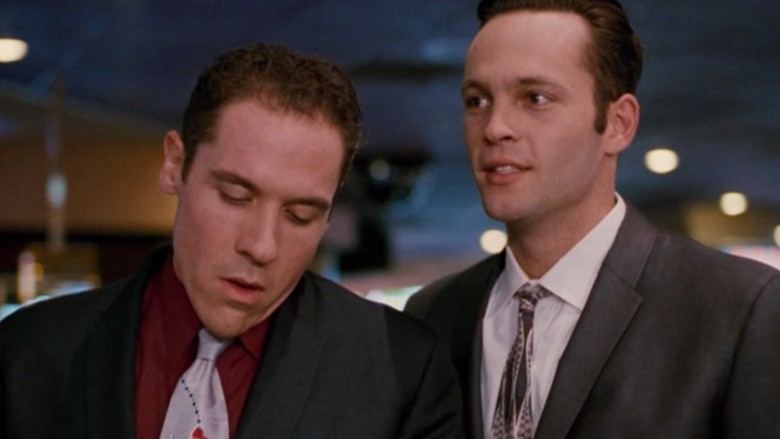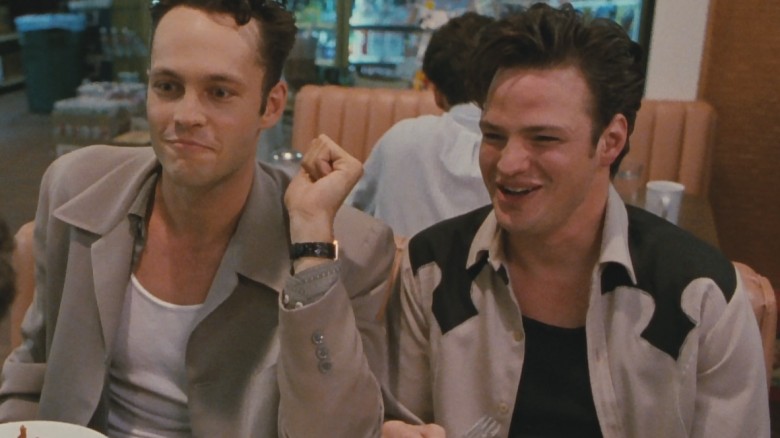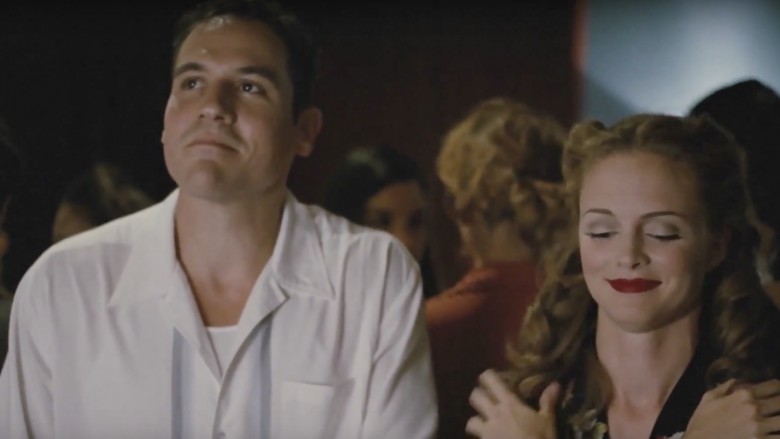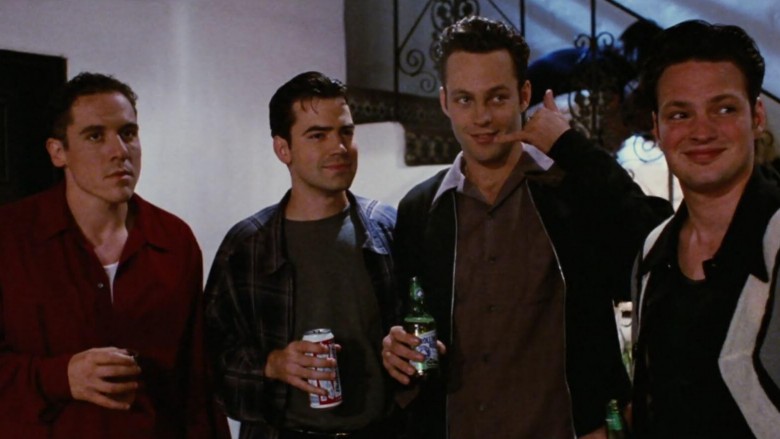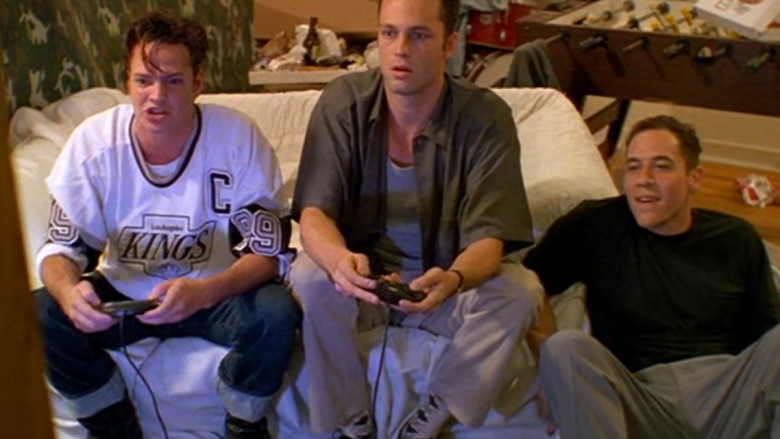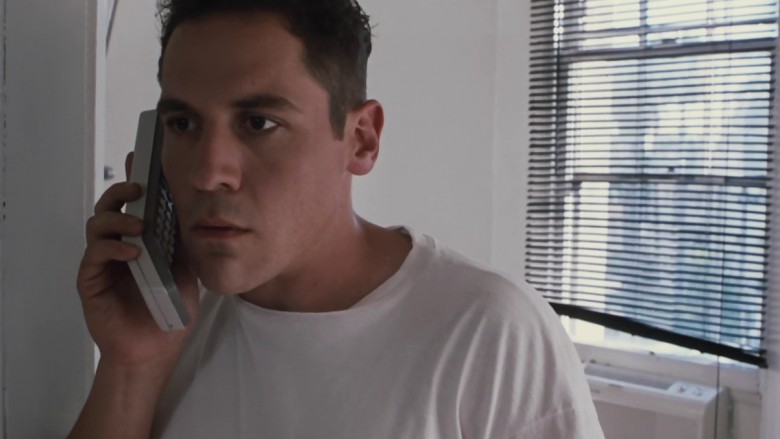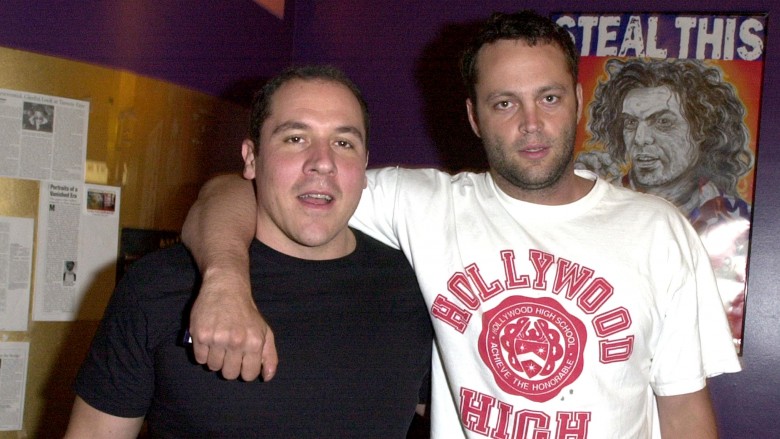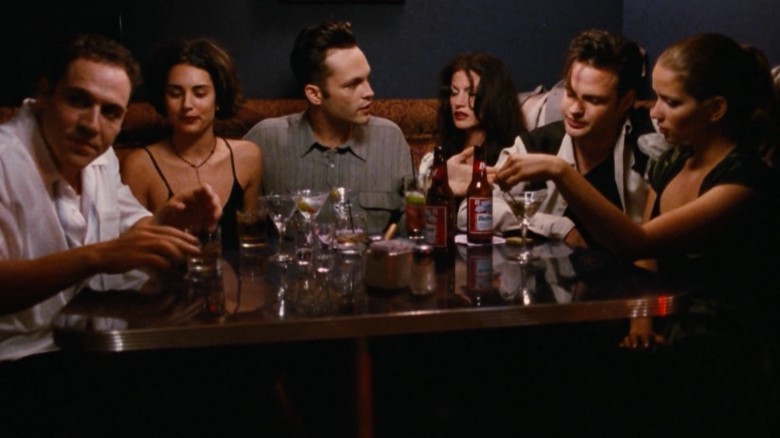The Untold Truth Of Swingers
Starring then-unknowns Vince Vaughn and Jon Favreau (who wrote the script based on his own experiences after getting dumped) as two down-on-their luck Los Angeles dudes just trying to get by, date women, and hang out in swing music bars, Swingers became a cult hit after being quietly released to theaters in 1996—and a pop culture phenomenon when it arrived on video. Here's a look at the unlikely success of Swingers, a movie so money it doesn't know how money it is.
The cast did staged readings to drum up interest
For more than a year before the movie started filming, the cast (Vaughn, Favreau, Ron Livingston, Alex Désert and others) held staged readings of the Swingers screenplay for invited audiences of potential investors (including a man believed to be an arms dealer) and movie industry bigshots. Vaughn says the readings would get "huge laughs" and "great responses," but very few actual takers. "They always felt the movie was funny but also very specific to out-of-work actors in Los Angeles. I think they all missed the universality of it."
Film executives had a lot of kooky suggestions
During the staged readings phase, Favreau hadn't yet considered playing Mikey, one of the two lead roles—he was just trying to sell his screenplay. He tried submitting it through the traditional Hollywood channels (through agents, having meetings) and once again was stymied by the lack of interest. Movie biz folks did, however, offer Favreau plenty of advice on how he could "improve" his movie. Among the ideas: change Vince Vaughn's character of Trent to a woman, not have the characters go to Las Vegas at all, add some violence, and cast Jason Priestley from Beverly Hills, 90210. Favreau tried to "embrace the notes," but he ultimately resisted.
The production had very little time…
Swingers had to film in just 18 days. Considering that a major movie will shoot about two script pages, or roughly two minutes of the final running time, each day, this meant that the cast and crew of Swingers had to shoot as much as 12 pages of script in a day. Favreau says that all the scenes in his character's apartment, which were shot in his actual apartment, were captured in a day and a half, which makes up roughly a quarter of the movie. Furthermore, the entire Las Vegas sequence was shot in one night.
…and very little money
Swingers' backers managed to raise $250,000, primarily from a business associate of director Doug Liman's father, a high-powered corporate lawyer. A lot of money, to be sure, but not much for a movie in 1996. Filmmakers had to get creative. The movie business was still pre-digital, which means the production had to shoot on real film—which is expensive. To cut corners, Liman shot on what are called "short ends," essentially excess cuts of film stock that are only 100 feet long...and which can capture about 60 seconds of footage. And because it would take at least four minutes of reloading time after every one minute of actual moviemaking, Liman employed the use of an Aaton 35, a documentary-style 35mm film camera.
The pros: It cheaper to rent and faster to reload. Con: It was extraordinarily loud—it was used for documentaries, projects in which crisply recorded dialogue isn't generally necessary. To alleviate that problem, Liman wrapped the camera in a down jacket, and then wrapped all that in a down comforter. That was enough to absorb the sound from the camera, and left the cast acting in front of what Favreau described as "a big, fluffy snowball." Expense was also spared for the film's lighting: basic, regular, everyday lightbulbs were all the production could afford, so Liman took to using environmental light whenever he could. The scene where Favreau stands in front of an open refrigerator? That's so they could use the fridge light.
The actors were really tight offscreen
Despite shooting in just 18 days, the chemistry between the actors, and their sense of character, are incredibly strong. That's because all of the main actors were friends offscreen, and Favreau based the characters on the actors he wanted to play them. (Alex Désert, who played Charles, says, "I like to say Swingers was us times 10. I wish I could be that cool.") The staged readings also helped lock things down. "By the time we got to the set, where we didn't have a lot of time and we were shooting a lot of pages a day," Favreau recalled, "we had already gone through the material so much and had chemistry from our relationship in our personal life, and that certainly made things easier. There was no learning curve."
The answering machine bit was based on an old Jeff Garlin routine
One of the most memorable scenes in Swingers is when Mikey (Favreau) leaves awkward message after awkward message on the answering machine of a girl he likes. Thankfully, for screenwriter Favreau's sake, this bit wasn't based on an actual incident in his life. During an appearance on his IFC interview series Dinner for Five, Favreau admitted to guest Jeff Garlin (Curb Your Enthusiasm) that he'd lifted the idea for the scene from a one-man show he'd seen Garlin do in Chicago in the early '90s. Nevertheless, director Liman didn't want to do the scene as written. "Liman was concerned that it was too many messages," said Favreau. "But I felt pretty strongly about it, having read it in front of audiences live, at staged readings."
A lot of scenes were filmed without permits
Filming in public places takes both time and money, both of which the production lacked. The makers of Swingers didn't, wouldn't, and couldn't wait around for permission to film in certain spots, nor could they afford to pay extras. So bar scenes were filmed while the bars were open—the background "actors" in those scenes are actual customers. (Filmmakers posted signs on the doors warning patrons that they were about to wander onto a de facto movie set.) Party scenes were actual parties being thrown by friends of the actors.
As for the scene where Mikey and Trent have a conversation while pulled over on a highway—the one where Trent tells Mikey he's "so money"—that was highly illegal. So illegal that the cast and crew were approached by state troopers...twice. The crew told the first trooper that they were just resting for a minute. The second trooper was told that they did have a permit, but it was back in their production office, and they'd have somebody go get it. While the crew and officer "waited" for the permit to arrive, the shoot continued for about half an hour while the trooper watched—at which point he got fed up and figured they were lying. He ordered filming to stop, and Liman had the crew pack up their gear as slowly as possible, all the while still secretly filming with a hidden microphone inside the car and the camera trained on Vaughn and Favreau without anybody watching in the viewfinder.
The baby for Trent's flirting scene was hired off the street
The scene in which Trent flirts with a woman from across a restaurant, only to realize that she's smiling at her own, theretofore unseen baby, almost didn't make it into the movie. (It's based on an experience Vaughn had at airport, just before Swingers started filming—he thought a man was waving and smiling at him...until he saw the man had a baby with him that Vaughn "couldn't see from my vantage point.") Re-creating the scene was almost a disaster, as the casting director accidentally selected a four-year-old child to play the baby. So as the crew set up at the diner, the locations manager was sent to a nearby supermarket to find a baby as quickly as possible—and he was kicked out for frantically asking parents, "Can we have your baby in our movie?" Right as the crew was running out of the natural light streaming through the windows needed to get the scene, a crew member spotted a car across the street with a baby seat, and offered the parents "$50 if we can have your baby for half an hour." Crisis averted.
It was rejected by Sundance
Many of the most famous, popular, and acclaimed "small" movies of the past 30 years or so came to prominence via a major film festival. In the '90s, a good showing at the Sundance Film Festival (created by Robert Redford in 1985) could make a movie—and its major players—an overnight sensation via a distribution deal. This happened for The Blair Witch Project, Reservoir Dogs, Memento, Hustle and Flow...but not for Swingers. While the movie has all the hallmarks of a classic '90s indie flick, Sundance said no to the movie in 1996. (It may have had something to do with the fact that Liman submitted an incomplete cut.) So the filmmakers staged their own miniature private Sundance. Right after the real festival ended, they rented a theater in Los Angeles and invited representatives from film distribution companies to come see Swingers. Miramax was in attendance, and bought the rights for $5 million.
It had a huge impact on pop culture
Swingers was among a handful of indie movies that rocked Hollywood in the '90s. Along with other unique, independently produced films such as Clerks and Pulp Fiction, Swingers brought a "visionary filmmaker" sensibility back to movies. It also made a huge star out of Vince Vaughn (The Lost World, Wedding Crashers) and an in-demand director out of Doug Liman, who went on to helm big blockbusters like The Bourne Identity and Mr. and Mrs. Smith. Swingers also jump-started the late '90s swing revival fad. Modern-day big bands like the Cherry Poppin' Daddies and Big Bad Voodoo Daddy (who are featured in Swingers) sold millions of records. But the biggest way Swingers changed American life: slang. The movie is credited with introducing the phrases "you're so money" and "Vegas, Baby!" into the vernacular.

